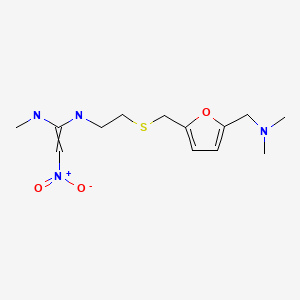Attribution Statement: LactMed is a registered trademark of the U.S. Department of Health and Human Services.
NCBI Bookshelf. A service of the National Library of Medicine, National Institutes of Health.
Drugs and Lactation Database (LactMed®) [Internet]. Bethesda (MD): National Institute of Child Health and Human Development; 2006-.
CASRN: 66357-35-5

Drug Levels and Effects
Summary of Use during Lactation
Although interpatient variability exists, the dose of ranitidine in breastmilk is less than the dose used in newborn infants. However, the finding that ranitidine spontaneously breaks down to a cancer-causing chemical caused its removal from the market in the US and other countries. Other drugs are recommended.
Drug Levels
Maternal Levels. Six women with established lactation who were 6 to 10 days postpartum were given a single dose of 150 mg of ranitidine orally. Average milk levels were 1.28, 1.42 and 1.02 mg/L at 2, 4 and 8 hours, respectively, after the dose; however, there was great interpatient variability in both peak levels and the time of the peak.[1]
After 5 oral doses of ranitidine 150 mg every 12 hours in a 54-day postpartum woman, the highest measured milk level occurred 5.5 hours after the 5th dose and was 2.6 mg/L. The estimated half-life in milk was 2.9 hours.[2]
Using the average peak milk level data from these 2 papers, an exclusively breastfed infant would receive an estimated maximum of 300 mcg/kg daily with a maternal dosage of 150 mg daily. This dosage is 20% of the dosage used intravenously in newborn infants for stress ulcer prophylaxis.
Infant Levels. Relevant published information was not found as of the revision date.
Effects in Breastfed Infants
One 54-day-old breastfed infant had no observable adverse effects after maternal ingestion of ranitidine 150 mg every 12 hours for 2 days.[2]
Effects on Lactation and Breastmilk
Histamine H2-receptor blockade is known to stimulate prolactin secretion.[3] Ranitidine in intravenous doses over 100 mg or during long-term oral use have increased serum prolactin in some studies, and rare cases of gynecomastia have been reported.[4-8] The prolactin level in a mother with established lactation may not affect her ability to breastfeed.
Alternate Drugs to Consider
Antacids, Cimetidine, Famotidine, Omeprazole, Pantoprazole, Sucralfate
References
- 1.
- Riley AJ, Crowley P, Harrison C. Transfer of ranitidine to biological fluids: Milk and semen. In: Misiewicz JJ, Wormsley KG, eds The clinical use of ranitidine Oxford: Medicine Publishing Foundation 1982:78-81.
- 2.
- Kearns GL, McConnell RF Jr, Trang JM, et al. Appearance of ranitidine in breast milk following multiple dosing. Clin Pharm. 1985;4:322–4. [PubMed: 4039999]
- 3.
- Knigge UP. Histaminergic regulation of prolactin secretion. Dan Med Bull. 1990;37:109–24. [PubMed: 2188799]
- 4.
- Perret G, Hugues JN, Louchahi M, et al. Effect of a short-term oral administration of cimetidine and ranitidine on the basal and thyrotropin-releasing hormone-stimulated serum concentrations of prolactin, thyrotropin and thyroid hormones in healthy volunteers. A double-blind cross-over study. Pharmacology. 1986;32:101–8. [PubMed: 3081918]
- 5.
- Delitala G, Devilla L, Pende A, et al. Effects of the H2 receptor antagonist ranitidine on anterior pituitary hormone secretion in man. Eur J Clin Pharmacol. 1982;22:207–11. [PubMed: 6125393]
- 6.
- Knigge U, Wollesen F, Dejgarrd A, et al. Comparison between dose-responses of prolactin, thyroid stimulating hormone and growth hormone to two different histamine H-2 receptor antagonists in normal men. Clin Endocrinol (Oxf). 1981;15:585–92. [PubMed: 6276054]
- 7.
- Tosi S, Cagnoli M. Painful gynecomastia with ranitidine. Lancet. 1982;2:160. [PubMed: 6123872]
- 8.
- Bera F, Jonville-Bera AP, Doustin P, et al. Therapie. 1994;49:361–2. [Impotence and gynecomastia secondary to hyperprolactinemia induced by ranitidine] [PubMed: 7878608]
Substance Identification
Substance Name
Ranitidine
CAS Registry Number
66357-35-5
Disclaimer: Information presented in this database is not meant as a substitute for professional judgment. You should consult your healthcare provider for breastfeeding advice related to your particular situation. The U.S. government does not warrant or assume any liability or responsibility for the accuracy or completeness of the information on this Site.
- User and Medical Advice Disclaimer
- Drugs and Lactation Database (LactMed) - Record Format
- LactMed - Database Creation and Peer Review Process
- Fact Sheet. Drugs and Lactation Database (LactMed)
- Drugs and Lactation Database (LactMed) - Glossary
- LactMed Selected References
- Drugs and Lactation Database (LactMed) - About Dietary Supplements
- Breastfeeding Links
- PubChem SubstanceRelated PubChem Substances
- PubMedLinks to PubMed
- Review Nizatidine.[Drugs and Lactation Database (...]Review Nizatidine.. Drugs and Lactation Database (LactMed®). 2006
- Review Cimetidine.[Drugs and Lactation Database (...]Review Cimetidine.. Drugs and Lactation Database (LactMed®). 2006
- Analysis of ranitidine in serum by high performance liquid chromatography.[Ther Drug Monit. 1980]Analysis of ranitidine in serum by high performance liquid chromatography.Vandenberghe HM, MacLeod SM, Mahon WA, Lebert PA, Soldin SJ. Ther Drug Monit. 1980; 2(4):379-84.
- [Dose-dependent effects of ranitidine on the transmural potential difference of the stomach].[Arzneimittelforschung. 1981][Dose-dependent effects of ranitidine on the transmural potential difference of the stomach].von Kleist D, Zschiedrich M, Stopik D, Hampel KE. Arzneimittelforschung. 1981; 31(6):1038-40.
- Lack of clinically significant in vitro and in vivo interactions between ranitidine and sucralfate.[J Pharm Sci. 1986]Lack of clinically significant in vitro and in vivo interactions between ranitidine and sucralfate.Mullersman G, Gotz VP, Russell WL, Derendorf H. J Pharm Sci. 1986 Oct; 75(10):995-8.
- Ranitidine - Drugs and Lactation Database (LactMed®)Ranitidine - Drugs and Lactation Database (LactMed®)
Your browsing activity is empty.
Activity recording is turned off.
See more...
